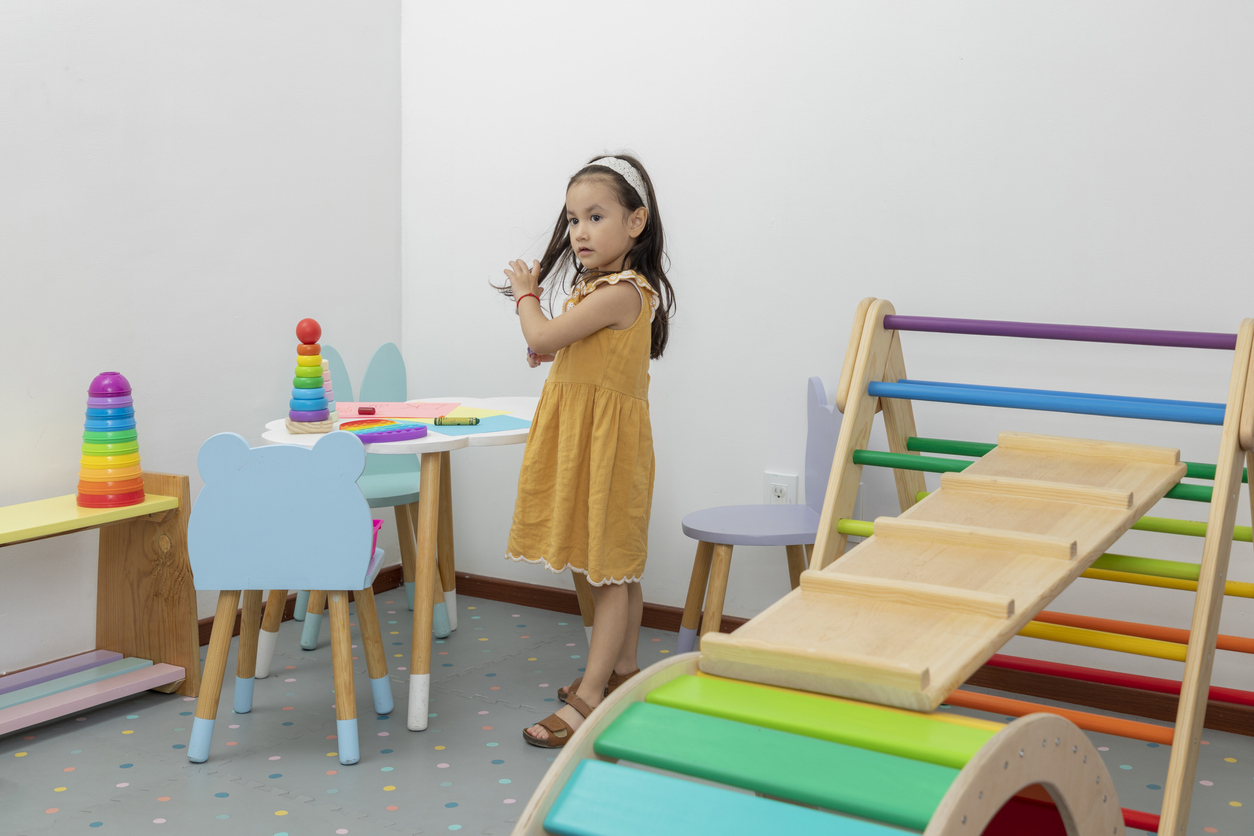
Speech therapy for kids is a crucial aspect of their overall development, focusing on improving their communication skills and addressing speech and language disorders that may arise during childhood. However, not all children progress at the same rate when it comes to speech and language skills. To ensure that they reach their full potential, some people may experience delays or disorders that call for intervention.
In this article, we will explore the question: “What age should a child go to speech therapy?” and delve into the significance of early intervention through speech therapy for kids, as well as the role of speech and occupational therapy in addressing these concerns.
Understanding Speech and Language Development
Understanding the typical course of speech and language development is crucial before talking about when to start speech therapy for kids. Reaching significant milestones along the way, children typically develop speech and language skills in a predictable order. It’s crucial to keep in mind that these milestones can vary slightly. A general timeline for speech and language development is provided below:
0-12 Months: Infants begin to coo and babble, making sounds like “ba-ba” and “goo-goo.” They begin to react to familiar voices and comprehend basic words like “mama” and “dada.”
12-24 Months: Toddlers start to use words to express their needs and desires. They gradually increase their vocabulary, and they are able to comprehend and carry out basic instructions.
2-3 Years: By this age, children are typically using short sentences and have a vocabulary of several hundred words. They are able to carry on simple conversations and pose inquiries.
3-4 Years: Children refine their speech sounds and grammar. They are able to engage in longer conversations, follow more intricate instructions, and tell stories.
Children at this age have speech and language abilities that are very similar to those of adults. They are able to participate in conversations, communicate their ideas and emotions, and adhere to complicated instructions.
This timeline serves as a general guide, but it’s important to keep in mind that each child is different and may achieve these milestones sooner or later than others. Additional factors that may affect speech and language development include bilingualism and hearing impairments.
Signs of Speech and Language Disorders
Different types of speech and language disorders can present, and they might not always be immediately obvious. Typical warning signs that children may require speech therapy include:
Limited Vocabulary: Compared to their peers their age, a child’s vocabulary is much smaller.
Speech Sound Errors: Persistent difficulty pronouncing sounds or substituting one sound for another (e.g., saying “wabbit” for “rabbit”).
Difficulty Following Directions: Struggles to understand and follow simple or multi-step instructions.
Limited Social Interaction: Difficulty engaging with peers or adults in conversation, making friends, or expressing emotions.
Stuttering: Repetition of sounds or syllables that repeatedly interrupt the flow of speech.
Late Speech Development: If a child is not reaching speech and language milestones within the typical age range.
Regression: A child loses speech or language skills they previously had.
The Importance of Early Intervention
When it comes to treating speech and language disorders in children, early intervention is essential. The more quickly a child receives therapy, the higher the likelihood of positive results. Early assistance can:
Maximize Potential: Since children’s brains are so plastic, learning and adapting come more easily to them. This plasticity is used by early intervention to assist kids in catching up to their peers.
Improve Communication: Speech therapy can enhance a child’s ability to communicate effectively, reducing frustration and improving their quality of life.
Enhance Academic Success: Strong communication skills are essential for success in school. Early intervention gives kids the best chance to succeed academically.
Boost Self-Esteem: Improved communication skills can boost a child’s self-confidence and self-esteem, leading to more positive social interactions.
When to Seek Speech Therapy
When should a child receive speech therapy is still an open question. The answer largely depends on the requirements and circumstances of the particular child. However, the following general rules can assist parents and caregivers in determining when to seek assistance:
Consult a Professional: It is advised to speak with a speech-language pathologist (SLP) or a pediatrician if you are worried about your child’s speech and language development. To find out if there is a real problem, they can perform assessments.
Early Intervention Programs: For kids with speech and language delays, many nations offer early intervention programs. These initiatives are made to spot problems and deal with them as soon as possible.
Trust Your Gut: As a parent or caretaker, you are the one who knows your child the best. Trust your gut and get professional help if you see persistent signs of speech and language problems.
Family History: It is advisable to be watchful and closely monitor your child’s development if there is a history of speech and language disorders in your family.
There is no set age at which one can begin speech therapy. While some kids may start as early as 18 months, others might start later. The secret is to deal with problems as soon as they emerge.
The Role of Speech and Occupational Therapy
Speech and occupational therapy play a big part in a child’s development, especially when it comes to disorders of speech and language. Despite their differences, these two therapeutic philosophies frequently collaborate to offer each child comprehensive support that is catered to their particular needs.
1. Speech Therapy:
The main focus of speech therapy is the development of speech and language abilities. Here’s a closer look at its function:
Speech therapists assist children in pronouncing sounds clearly. By instructing the proper tongue and lip movements for each sound, they improve speech clarity. The therapist will use exercises to address issues like a child saying “thun” instead of “sun” when they should be saying “thun,” for example.
Fluency: Speech therapists employ methods to enhance the flow and rhythm of speech for kids who stutter or have other fluency disorders. Techniques might include slowing down your speech, controlled breathing exercises, or desensitization to tense speaking situations.
Vocabulary and Language Development: A key goal of speech therapy is to help children develop their vocabulary and their capacity for understanding and using language. The child’s word bank is expanded by the therapists, and their comprehension and idea expression are also improved.
Social Communication: Speech therapy frequently includes social communication skill development. This entails instructing kids in conversational skills, understanding nonverbal cues, and effectively expressing their feelings.
Processing of Auditory Information: Some kids have trouble processing auditory information. Their capacity to comprehend and interpret what they hear, which is essential for language development, is improved with the aid of speech therapists.
2. Occupational Therapy:
The physical, sensory, and social facets of a child’s life are all covered by occupational therapy, which focuses on more general aspects of daily functioning. What it adds to speech therapy is as follows:
Fine motor skills, which are necessary for tasks like holding a pencil, buttoning a shirt, or handling small objects, are refined by occupational therapists. These abilities enable a child to participate in activities that support communication, like drawing and writing, so they are indirectly related to speech.
Sensory Processing: Many kids with speech and language disorders also experience difficulties with their sense of touch. Children with occupational therapy can better focus and participate in speech therapy sessions by managing their sensory responses.
Social Interaction: Interventions in occupational therapy frequently focus on enhancing social skills. Children gain the ability to understand social cues, communicate with peers, and handle social situations more adroitly. These abilities are easily transferable to interpersonal interaction and communication.
Behavior management: Children who struggle with speech and language may act out in challenging ways out of frustration or a lack of understanding. By helping to control these behaviors, occupational therapists can help to improve the environment for speech therapy.
Multidisciplinary Approach: When speech and occupational therapists work together to provide comprehensive support, it is frequently beneficial to take a multidisciplinary approach. They impart knowledge regarding the child’s development, difficulties, and strategies that can be coordinated to produce better outcomes.
LA Speech Therapy Solutions – Speech and Occupational Therapy For Kids
Are you ready to empower your child’s communication and developmental journey? At LA Speech Therapy Solutions, we specialize in providing top-notch speech therapy for kids.
Take the first step towards unlocking your child’s potential. Contact us today to schedule an assessment and personalized therapy sessions. Give your child the gift of speech and improved daily functioning, today!





